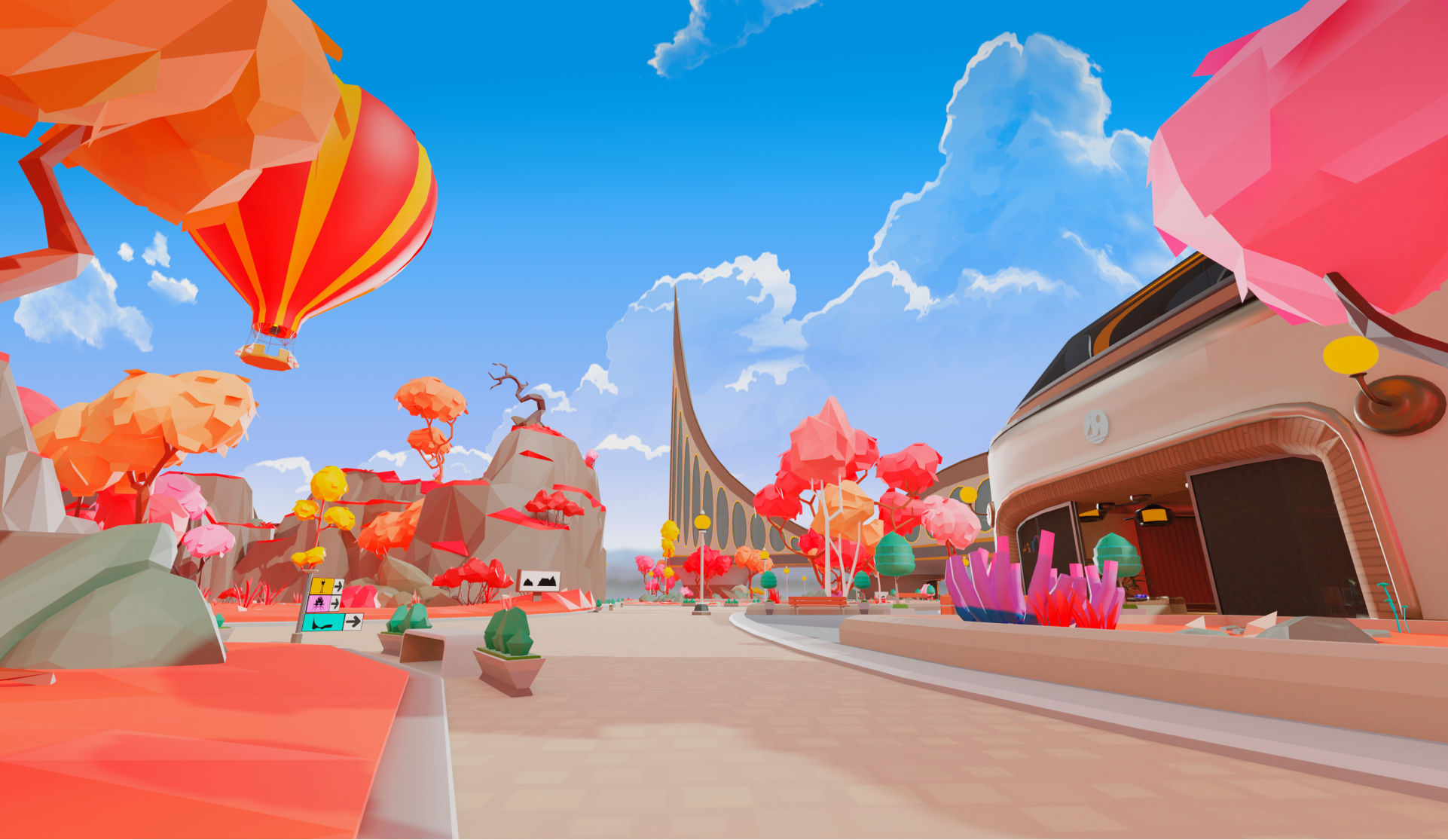Decentraland vs Sandbox: A Detailed Comparison (2024)
Understanding the metaverse
Before we dive into the detailed comparison of Decentraland and Sandbox, let’s first understand what the metaverse is. The metaverse is a convergence of VR and mixed-reality environments that can either be accessed through a web browser or a VR headset.
It’s a completely virtual world where users can interact, play games, buy virtual real estate, and even earn income.
Decentraland vs Sandbox: An introduction
We are about to introduce you to these two pioneering platforms. Take a look:
Decentraland
 Depicting Decentraland
Depicting Decentraland
Decentraland is a VR platform based on the Ethereum blockchain. Launched in 2017, it enables users to purchase virtual land, create and monetize content and applications. Decentraland is an open-source initiative, and it operates as a decentralized autonomous organization (DAO), giving MANA token holders voting rights over the rules and policies of the platform.
Looking to know about Decentraland’s bullish performance? Check out our blog to know more.
Sandbox
On the other hand, Sandbox started as a blockchain-based virtual world in 2011 and transitioned into a gaming-centric metaverse platform in 2017. It provides players with the tools to create, play, own, and monetize their gaming experiences. While Sandbox is not a DAO, it has hinted at developing its DAO in the future. Decoding Sandbox
Decoding Sandbox
Decentraland vs Sandbox: Comparing key features
Here is a comparison of the key features between Decentraland vs Sandbox:
Launch year and plots of land
Decentraland was launched in 2017 and offers 90,601 virtual plots of land. In comparison, Sandbox was launched a year later, in 2018, and provides 166,464 plots of land. This difference in the number of available land plots can potentially impact the value and scarcity of virtual real estate in these metaverses.
VR capabilities
Currently, both Decentraland and Sandbox do not support VR capabilities. However, there have been discussions about introducing VR support in Decentraland in the near future.
Tokens in circulation
Decentraland operates with its native ERC-20 token, MANA, with over 1.8 billion in circulation. On the other hand, Sandbox’s native token, SAND, also an ERC-20 token, has over 1.06 billion in circulation.
Wallet support and accessibility
Decentraland supports software wallets that can be integrated with browsers and recommends MetaMask. You don’t need a cryptocurrency wallet to play and explore Decentraland, but you do need one to unlock earning capabilities and purchase in-game non-fungible tokens (NFTs).
Sandbox requires a cryptocurrency wallet to sign up and play. It supports three software wallets: MetaMask, Bitskit, and Venly.
Fee structures
In the Decentraland marketplace, there’s a 2.5% MANA cost for all transactions. On the other hand, Sandbox charges a 5% fee for all transactions in its marketplace. Additionally, in both metaverses, users must pay a gas fee when interacting with the Ethereum blockchain.
Looking to know how to buy land and real estate in the metaverse? Our blog can help you with the basics.
Decentraland vs Sandbox: Inner workings
Take a detailed look into the inner workings of Decentraland vs Sandbox:
Working principle of Decentraland
Decentraland is best known for its infrastructure supporting shared virtual worlds. It comprises three layers: the consensus layer, the content layer, and the real-time layer.
The consensus layer uses smart contracts to track LAND ownership and content, while the LAND content layers render virtual content using a decentralized distribution system. The real-time layer provides P2P connections for users to interact with each other.
Working principle of Sandbox
Sandbox is a living virtual environment populated with user-generated creations. It provides tools such as VoxEdit and Game Maker, allowing players to create their own NFTs, such as avatars, virtual items, and even games.
Sandbox also allows users to utilize virtual products to communicate with different players. They can also trade their NFTs on the Sandbox Marketplace to earn money.
Metaverse is set to impact the economy drastically. But how? Read our detailed blog to know more. Comparing Decentraland vs Sandbox
Comparing Decentraland vs Sandbox
Decentraland vs Sandbox: Comparing additional metrics
Dive deep as we compare these additional features between Decentraland vs Sandbox:
Mission
Sandbox’s mission is to build a gaming system where creators can craft, play, share, and trade without central control. On the other hand, Decentraland’s mission is to establish a network that allows its content creators to own and capture the full value of their contributions.
Land plot number
Sandbox offers 166,464 land plots, while Decentraland has 90,601 plots. This difference in the number of land plots can impact the value and potential profits from virtual real estate projects in these metaverses.
Gaming experience
Sandbox offers a more robust gaming experience as it was initially designed for gaming. On the other hand, Decentraland focuses more on creating art and wearables, making it more suitable for artists.
Events
Sandbox plans to introduce virtual concerts in 2022, but it doesn’t currently offer many concerts or events. On the other hand, Decentraland hosts more events, concerts, and art shows, making it a more active metaverse for event-goers.
Fees
Sandbox charges a fee of 5% in SAND, while Decentraland requires a fee of 2.5% in MANA for transactions in their respective marketplaces.
Learn more about the top 9+ metaverse companies and stay ahead of your peers in 2024.
Which metaverse should you choose?
The choice between Decentraland vs Sandbox depends on your personal preferences and what you want to achieve in the metaverse. Here are a few factors to consider:
- Functionality: If you’re a gamer, Sandbox might be a better option due to its gaming-focused mission. If you’re an artist, Decentraland offers more opportunities for creating and selling artwork.
- Token value: The value of Sandbox’s SAND and Decentraland’s MANA tokens can impact your potential earnings from selling tokens.
- Earning money: Both metaverses allow you to earn money. However, Sandbox’s simple play-to-earn option might be more appealing if you prefer straightforward gaming activities.
- Cost of the land: The cost of virtual land in either metaverse can be expensive, with the cheapest plot costing over $1,750 in Sandbox and over $2,300 in Decentraland.
Remember, both Decentraland and Sandbox offer unique opportunities and experiences. The choice between them depends on your personal preferences, objectives, and what you hope to accomplish in the metaverse.
Here’s everything you need to know if you want to run a successful advertising campaign in metaverse today! Users leveraging the potential of metaverse
Users leveraging the potential of metaverse
Wrapping up
Both these platforms are pioneers in the rapidly growing metaverse space. Each platform offers unique opportunities and experiences for users. While Decentraland is more established and has a clear governance structure through its DAO, Sandbox offers a more robust gaming experience and has a detailed roadmap for future developments.
Ultimately, the choice between Decentraland vs Sandbox will depend on your personal preferences and what you hope to achieve in the metaverse. Always do your research and consider all factors before making a decision. The metaverse is still in its early stages, and the landscape is likely to evolve and change in the coming years.








































